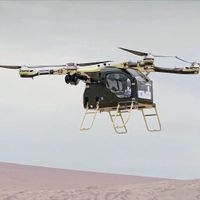Xpeng Aeroht, the flying car subsidiary of Chinese electric vehicle giant Xpeng, has just achieved a historic milestone in the race to bring flying cars to the masses. On September 11, 2025, the company announced it had secured a special flight permit for its Land Aircraft Carrier modular flying car in the United Arab Emirates (UAE), marking the first time a Chinese flying car company has received such authorization overseas, according to CnEVPost and Techeblog.
This achievement is more than just a regulatory checkbox. It paves the way for Xpeng Aeroht to conduct manned flight tests across multiple locations in the UAE, with the inaugural flight scheduled for Dubai this October. The UAE, which has become something of a global playground for futuristic transportation experiments, offers a uniquely welcoming regulatory environment for such innovation. As Techeblog notes, the country’s forward-thinking approach to technology and transportation means fewer bureaucratic hurdles and a greater appetite for bold new ideas. For Xpeng Aeroht, it’s the perfect launchpad to prove its flying car is more than just a science fiction fantasy.
Xpeng Aeroht’s modular flying car, dubbed the Land Aircraft Carrier, is the product of a staggering 12 years of research and development and an investment of approximately $600 million. Over that time, the design went through seven distinct iterations, each refining the balance between roadworthiness and flight capability. The result is a system that’s as bold in concept as it is in execution.
So, what exactly is the Land Aircraft Carrier? It’s a two-part system: a flying vehicle and a so-called “mother vehicle.” The mother vehicle operates much like a conventional electric car on the road, but it doubles as a mobile charging station for the flying unit. When the driver is ready to take to the skies, the flying vehicle detaches from the mother vehicle and uses electric vertical takeoff and landing (eVTOL) technology to lift off. This modular setup, as described by both CnEVPost and Techeblog, elegantly solves one of the biggest challenges in flying car design—how to ensure that neither the car’s ability to drive nor its capacity to fly is compromised.
According to company founder and president Zhao Deli, who spoke at a media event on September 3, 2024, the Land Aircraft Carrier will be priced at around RMB 2 million, or roughly $280,860. That’s a hefty sum, but for a vehicle that can drive to a field, detach, and soar above traffic, it represents a glimpse into a future where personal air travel is not restricted to the ultra-wealthy. Zhao also confirmed that mass production and delivery are targeted for 2026, with the price cap firmly in place to keep the vehicle within reach of early adopters.
The interest is already substantial. In China alone, Xpeng Aeroht has received nearly 5,000 pre-orders for the Land Aircraft Carrier, signaling a strong appetite for futuristic transportation solutions among consumers. At Xpeng’s Tech Day event on October 24, 2023, company executives outlined a development path that includes both eVTOL flying cars and modular flying cars, with the Land Aircraft Carrier serving as a flagship example of the latter. The company’s vision is nothing short of transformative: to enable people to bypass traffic jams by taking to the air, all with the convenience and flexibility of a modular, dual-purpose vehicle.
To support these ambitious goals, Xpeng Aeroht began construction of its flying car manufacturing base in October 2024. The facility is designed with an annual production capacity target of 10,000 units, a figure that underscores the company’s confidence in both domestic and international demand. In May 2025, the Civil Aviation Administration of China accepted the Production Certificate application for the Land Aircraft Carrier’s flying unit, kicking off the official review process that will determine when mass production can begin in earnest.
Financial backing has been robust as well. In July 2025, Xpeng Aeroht completed a $250 million Series B funding round, which is expected to accelerate the ramp-up to mass production. With this influx of capital, the company is well-positioned to scale up manufacturing and meet the anticipated demand both at home and abroad.
The upcoming manned flight tests in the UAE will be a critical proving ground for the Land Aircraft Carrier. As Techeblog puts it, these real-world tests will allow Xpeng Aeroht to "put the Land Aircraft Carrier through its paces," providing invaluable data on reliability, safety, and performance. Success in these tests could open the door to broader international acceptance and, eventually, commercial deliveries outside China. The first flight in Dubai, scheduled for October 2025, is expected to be a high-profile event, drawing attention from industry watchers, regulators, and tech enthusiasts around the world.
What makes the UAE such an attractive testing ground? For one, the country’s government has made it clear that it wants to be at the forefront of transportation innovation. The regulatory environment is less restrictive than in many Western countries, allowing companies like Xpeng Aeroht to experiment and iterate more freely. This willingness to embrace new technologies has already made the UAE a hotspot for autonomous vehicles, drone deliveries, and now, potentially, flying cars.
Still, challenges remain. Bringing a flying car to market involves more than just building a working prototype. Regulatory approval, safety certification, and public acceptance are all significant hurdles. But Xpeng Aeroht’s progress so far—culminating in the first overseas special flight permit for a manned flying car by a Chinese company—suggests that the company is well on its way to overcoming them.
According to CnEVPost, the modular flying car’s system is designed to be as user-friendly as possible. The mother vehicle not only recharges the flying unit but also transports it to optimal takeoff locations, making the transition from road to air as seamless as possible. This approach could be a game-changer for urban mobility, especially in congested cities where traditional infrastructure is stretched to its limits.
Looking ahead, Xpeng Aeroht’s plans are as bold as the technology itself. With deliveries scheduled to begin in the second half of 2026 and an annual production target of 10,000 units, the company is betting big on a future where flying cars are not just a novelty, but a practical solution to everyday transportation woes. If the upcoming tests in the UAE are successful, that future might just be closer than we think.
The story of Xpeng Aeroht’s Land Aircraft Carrier is one of relentless innovation, significant financial investment, and a willingness to challenge the status quo. As the world watches the skies over Dubai this October, one thing is clear: the age of the flying car is no longer a distant dream, but a fast-approaching reality.




